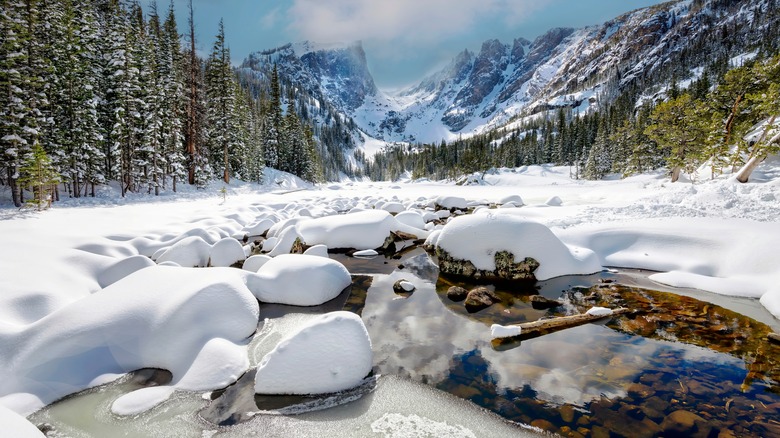This US National Park Is A Hidden Gem For Outdoor Adventures
"It is the course of wisdom to set aside an ample portion of our natural resources as national parks and reserves, thus ensuring that future generations may know the majesty of the earth as we know it today," said President John F. Kennedy in 1962, per NPS. It was true then, and it's still true today. When it comes to the best national parks, the Grand Canyon or Yellowstone may be top of mind, and while those certainly can be once-in-a-lifetime vacation destinations, you can also find majestic beauty and lots to do at Rocky Mountain National Park.
About a two-hour drive northwest of Denver, Rocky Mountain National Park spans over 400 miles, with over 300 miles of hiking trails through mountain meadows and tundra, along alpine lakes, and to the top of impressive peaks. It's one of the country's highest national parks with dozens of mountains over 12,000 feet tall. Much of Rocky Mountain National Park is Wilderness — officially, a capital "W" for wilderness — thanks to a designation from Congress in 2009. The areas with this designation are protected from human impact as much as possible and as such, they have some of the most beautiful views and allow you to feel like you're a part of nature. You can expect to see a range of wildlife, like mule deer, marmots, and elk, which are particularly active during the fall rut season.
There is hiking for everyone at Rocky Mountain National Park
One of the best ways to get a feel for Rocky Mountain National Park is to get out on the trail. Whether you're a beginning hiker or an experienced backpacker ready to camp out in the wilderness, Rocky Mountain National Park has something for you. If you're traveling with family or anyone in a travel stroller or a wheelchair, the short Sprague Lake hike is ideal. You get views of the mountains along the Continental Divide while walking along a 0.7-mile loop with little elevation change.
For lake views with more of a climb, the 2.2-mile hike to Dream Lake from the Bear Lake Trailhead takes you through quivering aspen groves to a couple of alpine lakes. The park also has some pretty waterfalls you can access on foot, like Cascade Falls on the North Inlet Trail. While you may be tempted to swim in the waterfalls and lakes in the park, swimming is banned in some of them, like Bear Lake, and the water is an uncomfortably chilly 50 degrees Fahrenheit.
For the more ambitious and experienced hiker, the 23-mile Long's Peak Valley Loop gives you a feel for a large part of the park with backcountry camping available. For another challenge, Long's Peak — the only peak over 14,000 feet in the park aka "a fourteener" — can be a long day hike (think around 16 hours) or split up into a two-day backpacking adventure.
Rocky Mountain Park is fun in winter, too
Summer may be the high season, but there are still ways to get out and enjoy the wilds of Rocky Mountain National Park in the winter, and there will be fewer crowds. You can go cross-country skiing and snowshoeing on many trails in the park, as well as on the iconic Trail Ridge Road. It's the highest continuously paved highway in North America, and it's closed to cars during winter. It's hard work going up to Milner Pass at 10,759 feet, but you'll be rewarded with beautiful views of Poudre Lake.
There's also some classic alpine climbing throughout the park, which can be guided or self-led excursions. After the snow melts, you can bike down Trail Ridge Road in the high season — there are tour operators who will take you up by shuttle so you can ride down. Keep in mind, bikes are allowed on the roads in the park, but not on the trails.
When it comes to the practicalities of planning your trip, your gateway to the park is the nearby town of Estes Park, which is well worth exploring. Parking lots can fill up quickly, so take advantage of the free shuttle buses that can drop you off at major spots in the park as well as to and from Estes Park. During peak summer months, you'll need to purchase a timed entry pass — you can find updated details at the National Park Service website.


